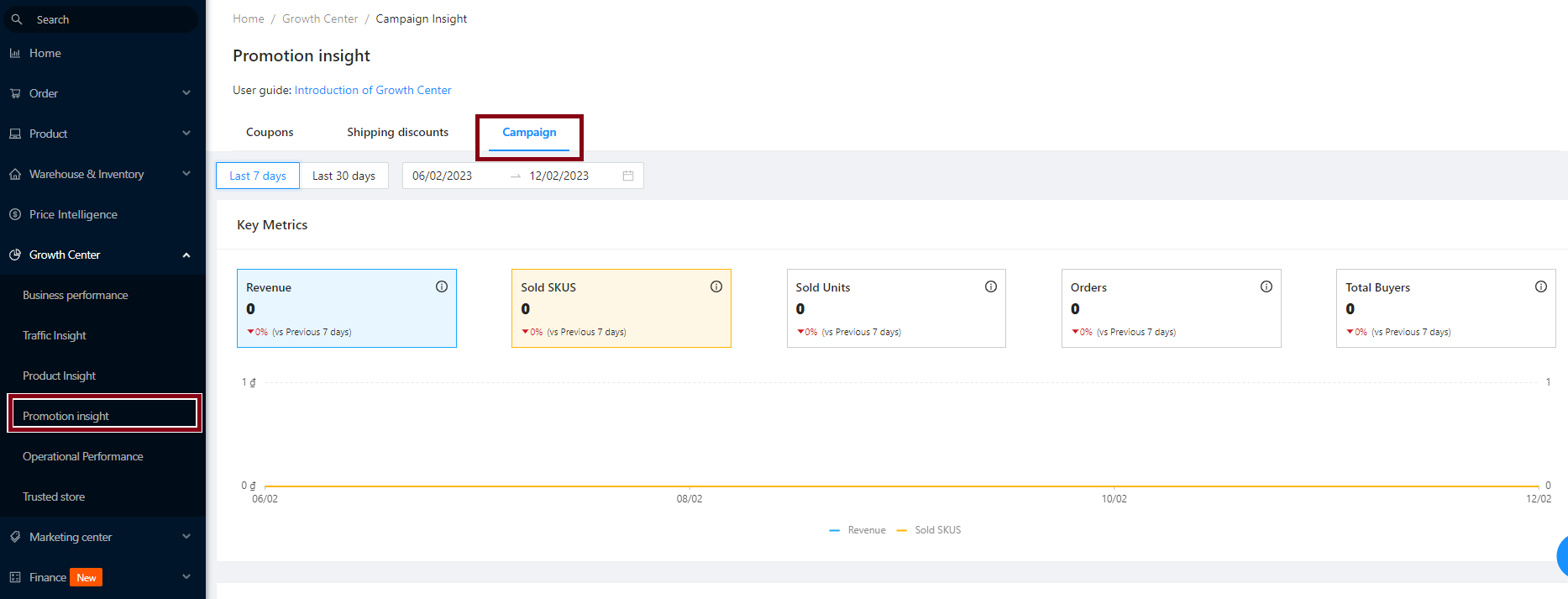Category deal
Category Deal is one of Tiki’s promotional campaigns. Sellers will be able to register to participate in the program with the appropriate category depending on the time of year and the category’s development strategy. These campaigns will run for various periods and will be announced to consumers through banners on the Tiki website/app.
Benefits:
-
Increase product visibility and help products reach customers more quickly.
-
Increase conversion rate
-
Increase sales revenue
Seller can enroll for Category deal promotion by 2 methods:
Method 1: Flash sales are always displayed first in the Tiki’s campaign section on the Seller Center homepage, sellers can click on Register now or select All campaigns to see the campaign list. Category deal campaigns will be labeled in blue badge.

Seller Center homepage
Method 2: Seller selects Marketing Center > Promotion tools > At the Tiki’s campaign section, select All campaigns to see a list of available programs.
Here, sellers can easily search by different campaign statuses: Upcoming, Ongoing, Finished.
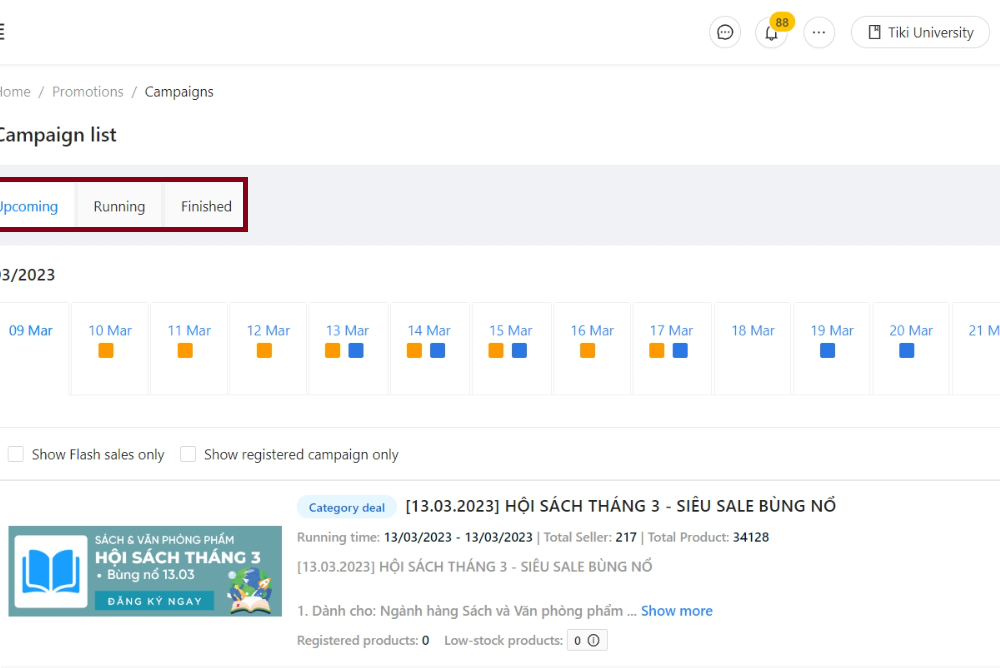
The campaign list
Campaign list displays 3 tabs to help sellers manage easily: Upcoming, Running and Finished.
Upcoming:
-
All upcoming promotions are shown, along with the registration deadlines. Sellers can filter the list of registered promotions.
-
If the campaign is still open for registration, a Register button will appear. To participate in the program, the seller clicks on the Register button.
-
If the registration period for the promotion has expired (but the due date has not yet passed), there will be a View Details option.
Running: display the ongoing campaigns. You can:
-
View details: Direct to campaign detail page
-
View reports: Link to Growth Center to view Campaign performance report
Finished: display ended campaigns. You can:
-
View details: Direct to campaign detail page
-
View reports: Link to Growth Center to view Campaign performance report

1. Add products directly
Step 1: On the program’s details page, the seller will see the program information, participating categories, and available scheme after selecting the program you wish to participate in from the Upcoming section. The seller selects the scheme in which they wish to participate and click Register.
Note: In each campaign, a product can only engage in one scheme. Sellers may use Google translate to translate the available schemes.

Step 2: Sellers add products directly by clicking Add product. At this time, the screen will display a list of eligible products that can participate in the program. Criteria: Product rating is >=3, or no rating at all.

-
At this stage, sellers can search by Product Name or SKU and filter by category.
-
To add, sellers can choose specific products from the left table by clicking + symbol or Select entire page (maximum 50 products/page). You can select a maximum of 250 products for each registration. To remove products, please choose products from the right table and click on x or Remove all.
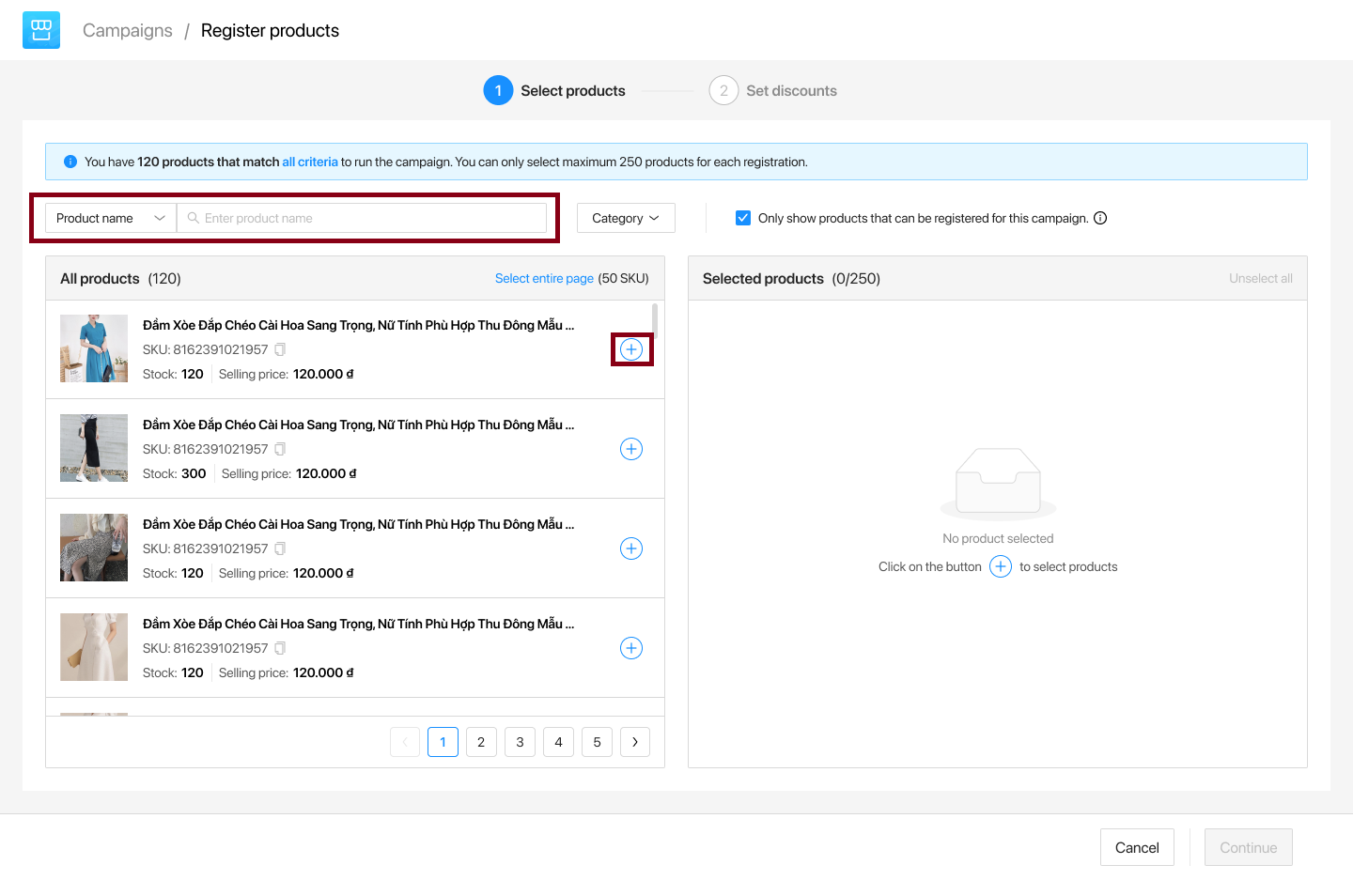
Note: If the seller participates in multiple campaigns with the same running time, Tiki will report an error at this stage, right at the time you register. .
Case 1:
-
The seller has registered product X with campaign A, and the registration period for campaign A is still active (that is, the product has not been allocated by the system).
-
The seller registers product X for campaign B.
Therefore, since campaign A and campaign B have the same running time, Product X cannot join campaign B until the seller removes product X from campaign A.
At this point, the system will display the following message below product X: SKU was registered in another campaign. Sellers can view previously registered duplicate campaign information by hovering the mouse over the (i) icon next to the notification.
Case 2:
-
The seller applied product X to campaign A, which has since expired (i.e. product is waiting for being allocated or has been successfully allocated to campaign A).
-
The seller registers product X for campaign B.
Therefore, since campaign A and campaign B have the same running time > Product X cannot join campaign B.
Depending on when the product was allocated or is waiting to be allocated to campaign A, the system sends one of two messages below product X at this time:
-
SKU is waiting for allocation of another campaign; or
-
SKU is currently registered for another campaign.
Sellers can view previously registered duplicate campaign information by hovering the mouse over the (i) icon next to the notification.
Then, click Continue to set the price, stock and purchase limit for the product.
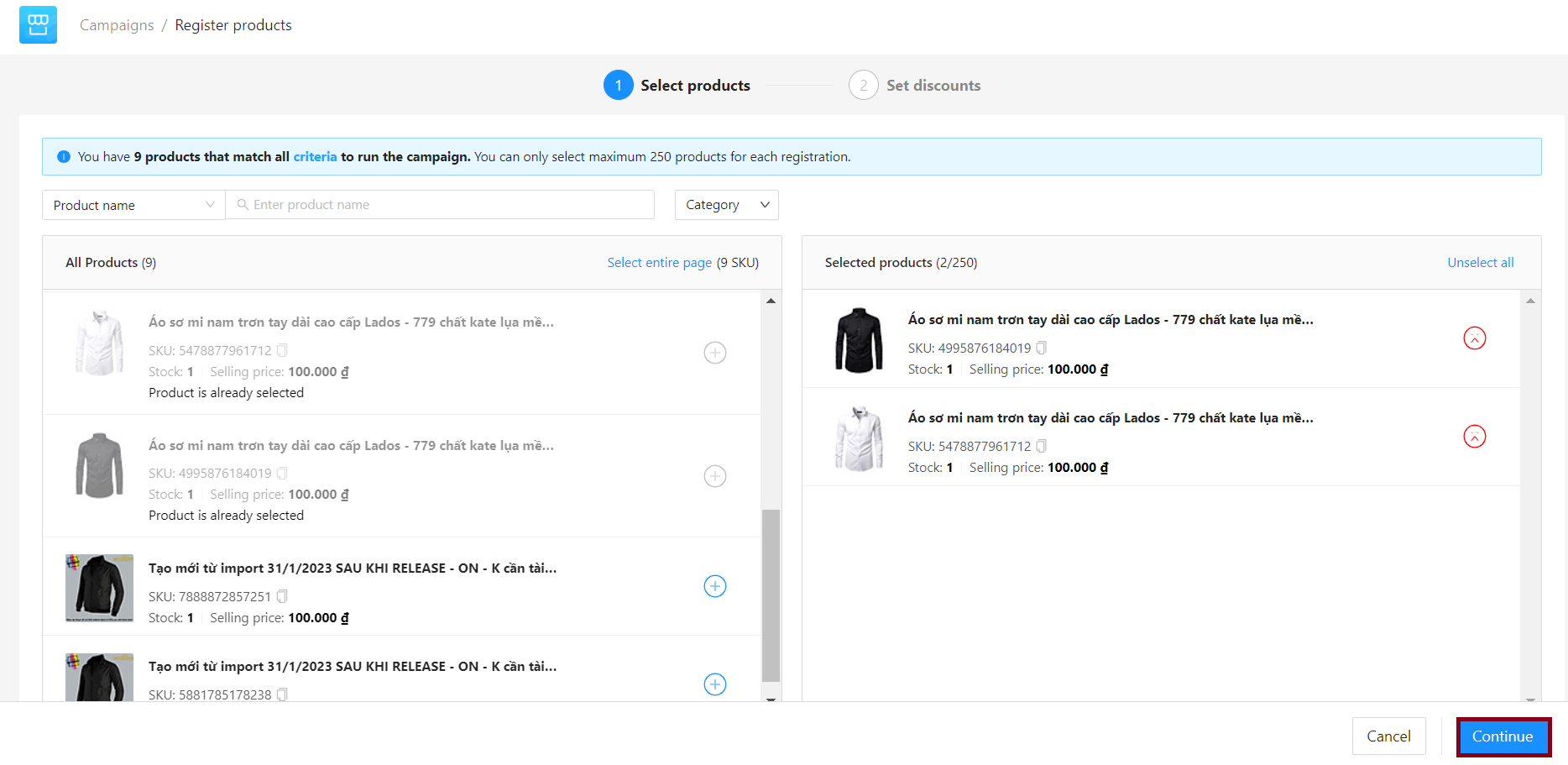
Step 3: Setting discount price, discount quantity and purchase limit
The system will automatically suggest a valid discount price and quantity according to each promotional scheme selected earlier by the seller. Discount price and discount quantity is editable, in which:
-
Discount price: Must be less than or equal to the suggested price and match the requirements of the promotional scheme.
-
Discount quantity: Must be greater than or equal to the recommended quantity. Tiki encourages Sellers to increase this number according to sellable stock to avoid selling out when the new campaign starts.
In case you have entered the discount price and discount quantity but still wish to see the system’s suggestion, please hover over the Discount price/Discount quantity box.
- Purchase limit per order: The maximum number of products a customer can place on an order. Purchase limit must be less than or equal to Discount quantity.
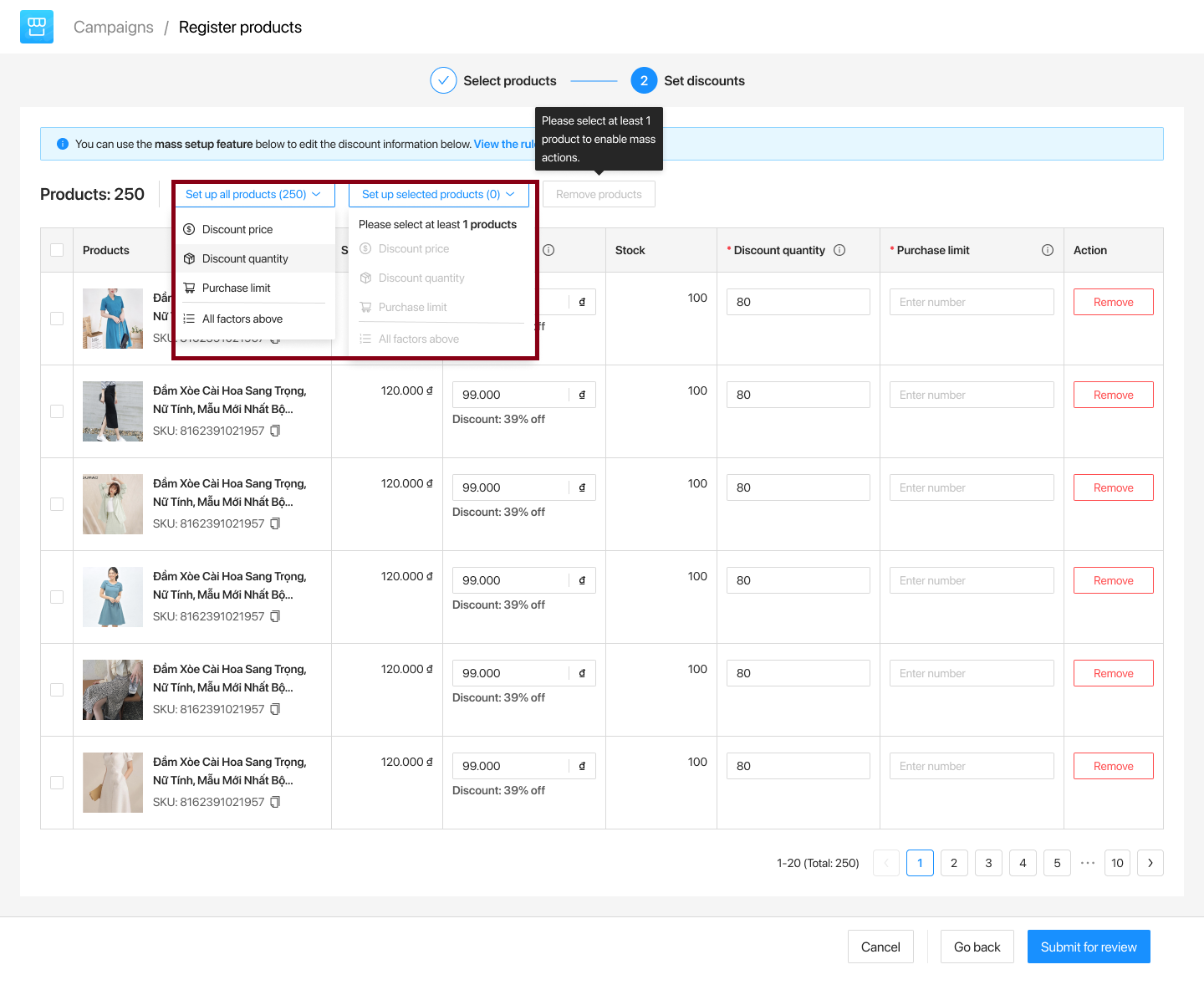
Sellers can perform mass actions when setting discounts for all products or selected products by: Discount price (in % or by amount), Discount quantity, Purchase limit or All factors above. Then click Apply.
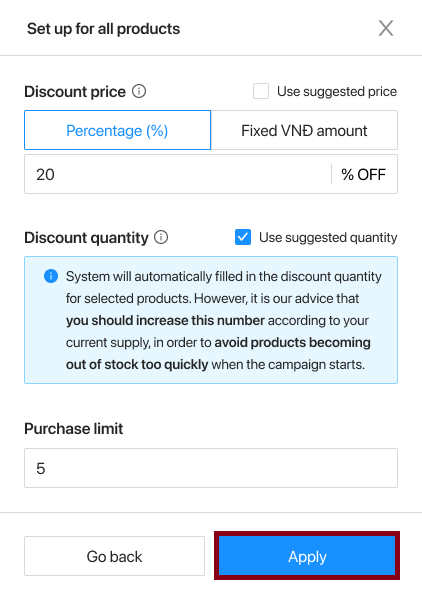
Step 4: Seller click Submit to review. The list of products will be displayed in the Approved section.
2. Mass import products
The seller selects the scheme in which they wish to participate and click Register. Note: In each campaign, a product can only engage in one scheme.
Step 1: Download eligible products file, including suggested price and stock.
Template 1: Sellers click on Export eligible products to download an import sample which include information on SKU, suggested price and and suggested quantity by the system.
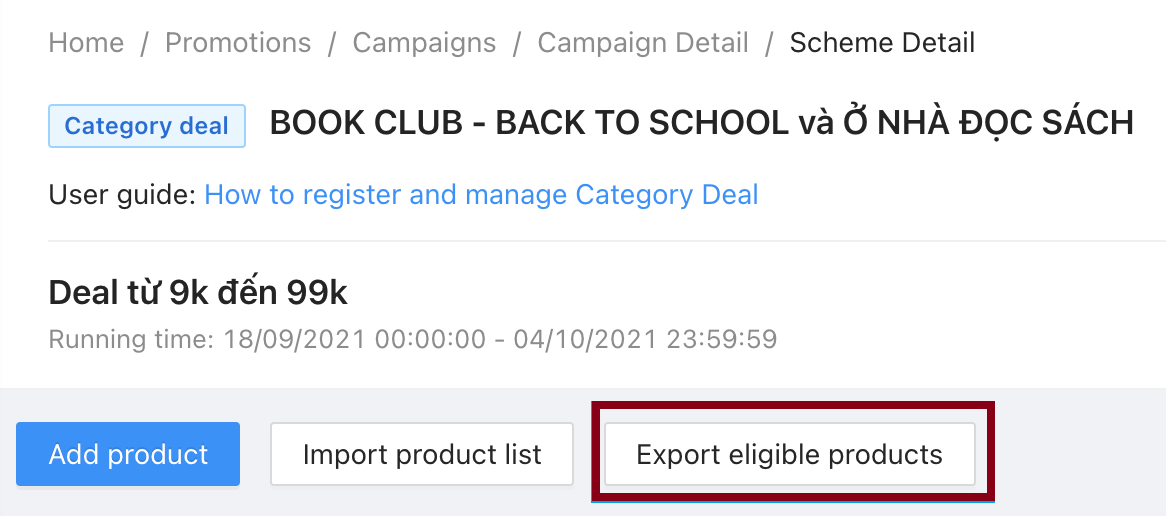
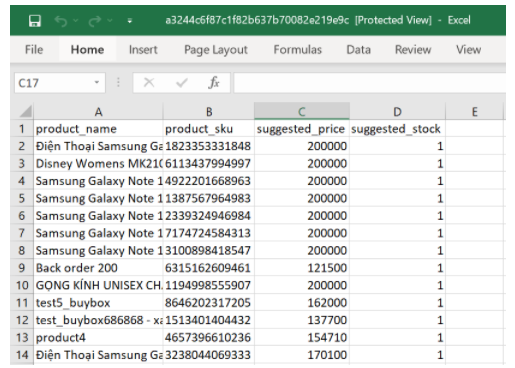
Template 1
Step 2: Import product list for registration
Step 2.1 After getting the list of eligible products (Template 1), select Import product list then select Download import template (Template 2).
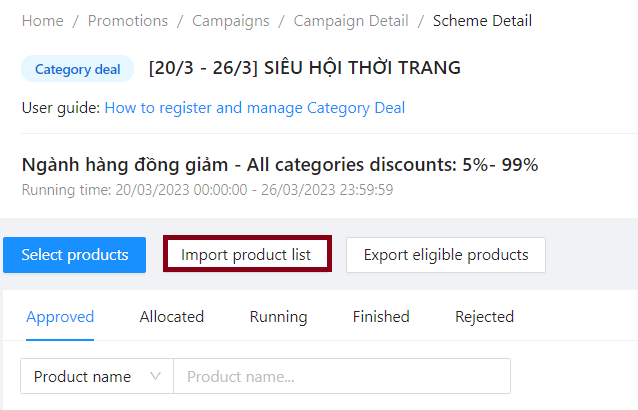

Fill in the products the seller wants to register from Template 1 to Template 2, including SKU, price, quantity and limit_quantity

Template 2
Notes:
-
Value in the price column must be less than or equal to suggested price.
-
Value in the quantity column must be greater than or equal to the number of proposals.
-
Value in the limit_quantity column (Purchase limit) must be less than or equal to the discount quantity.
Step 2.2: Import product list
Sellers go back to the Import product list tab at Step 2.1, then Drag and drop to upload the edited file (Template 2).
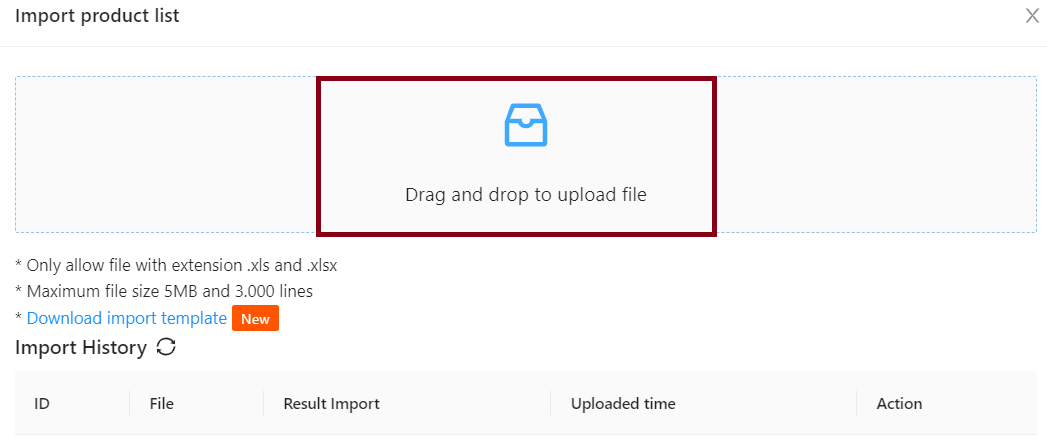
Step 3: Check import result.
-
The Import History section will display all the files that you have uploaded.
-
The Result Import column shows the number of approved and disapproved products:
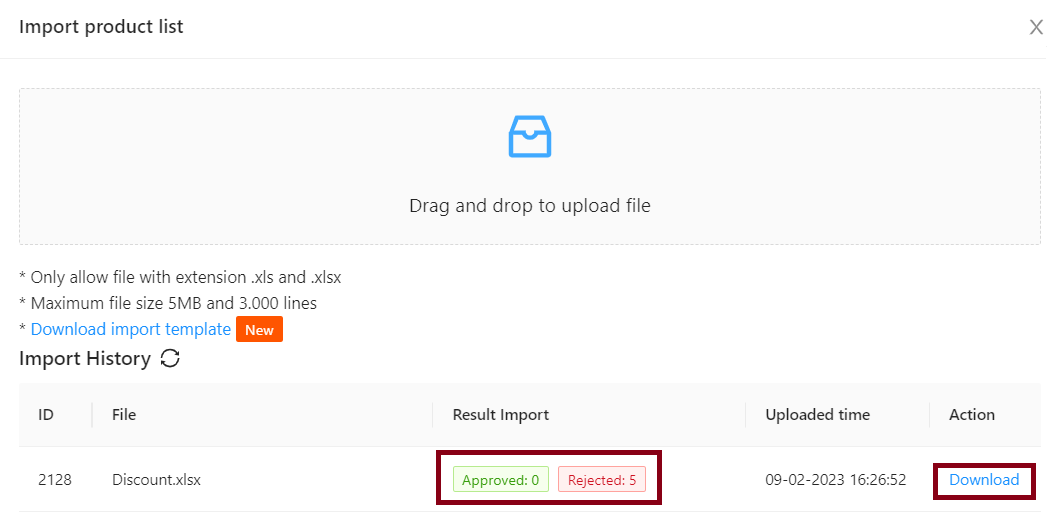
The newly created product list will be displayed in the Approved section at the Campaign scheme details. Sellers can press F5 to refresh the page to approved products on this page. You can also select Export data below each item to view the corresponding product list.
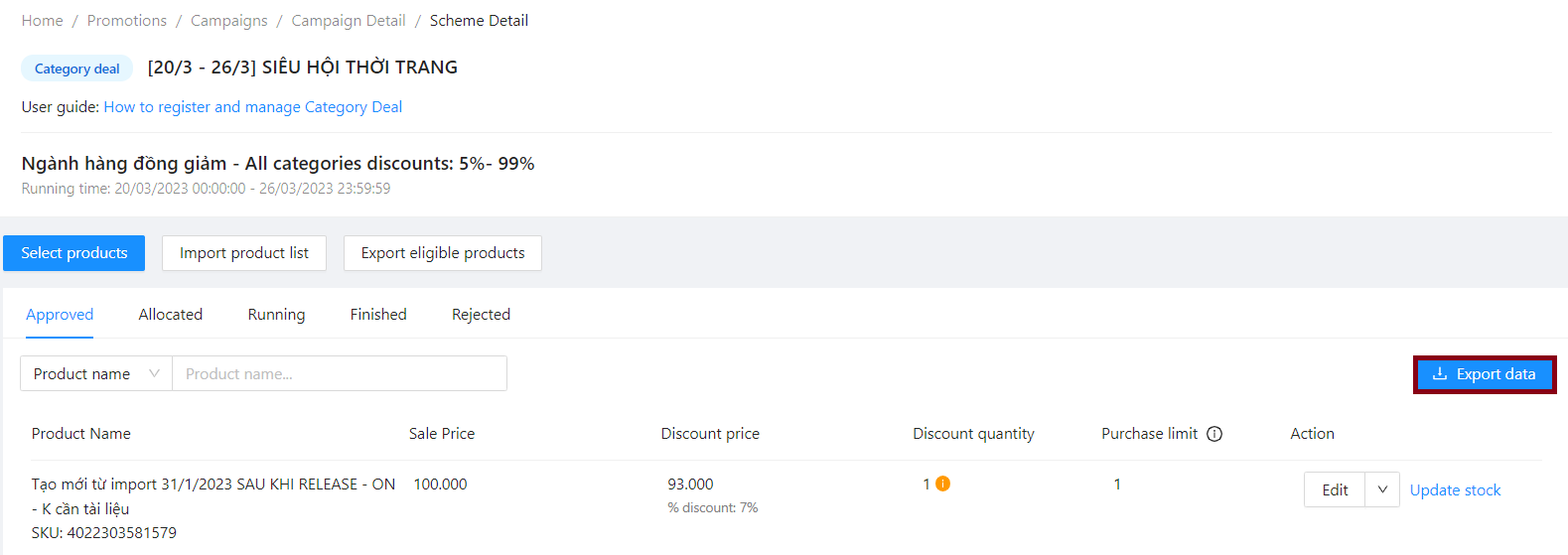
Tiki will prioritize the following product promotions in order to ensure that they reach customers in the best and most consistent way possible:
1. Flash sale – Top priority
2. Category deal – Second priority
3. Price discount – Third priority
When a product participates in more than one promotion with partially or completely overlapping running times, the system will use priority to determine which promotion is applicable at any time, allowing the seller’s promotions to run continuously. When a campaign’s runtime expires, the system will continue to trigger the next lower-priority campaign.
Examples:
-
Product A participates in Flash sale on December 15
-
Product A participates in Category deal continuously from December 10 to December 17
-
Product A participates in Price discount continuously from December 1 to December 31
Based on priority, promotions will be applied to product A in stages as follows:

At any given time, the seller cannot register more than one campaign for each type of promotion (Flash Sale, Category Deal, or Price Discount). The system will notify you if you register for the same campaign twice.
After product registration is completed, you need to track the inventory of registered products, the distribution results of the promotion campaign (deal duration) and business results, by:
Step 1: Go to Seller Center > Promotions > Campaigns, select View details or Register to enter the detail page of a campaign.
Step 2: Select the promotional scheme that the seller registered in the details page to track the status of registered products The Campaign Details page consists of 5 main sections, showing the status of participating products, displayed as tabs. You can choose Export data to see a list of products corresponding to each status.
1. Approved tab
Displays a list of products that have been approved by the system after you registered.
Depending on the program’s subscription term, sellers may edit prices, product enrolled quantities, or delete products, until the program subscription expires. Sellers need to pay attention to the program registration deadline in the Upcoming section with a countdown timer.
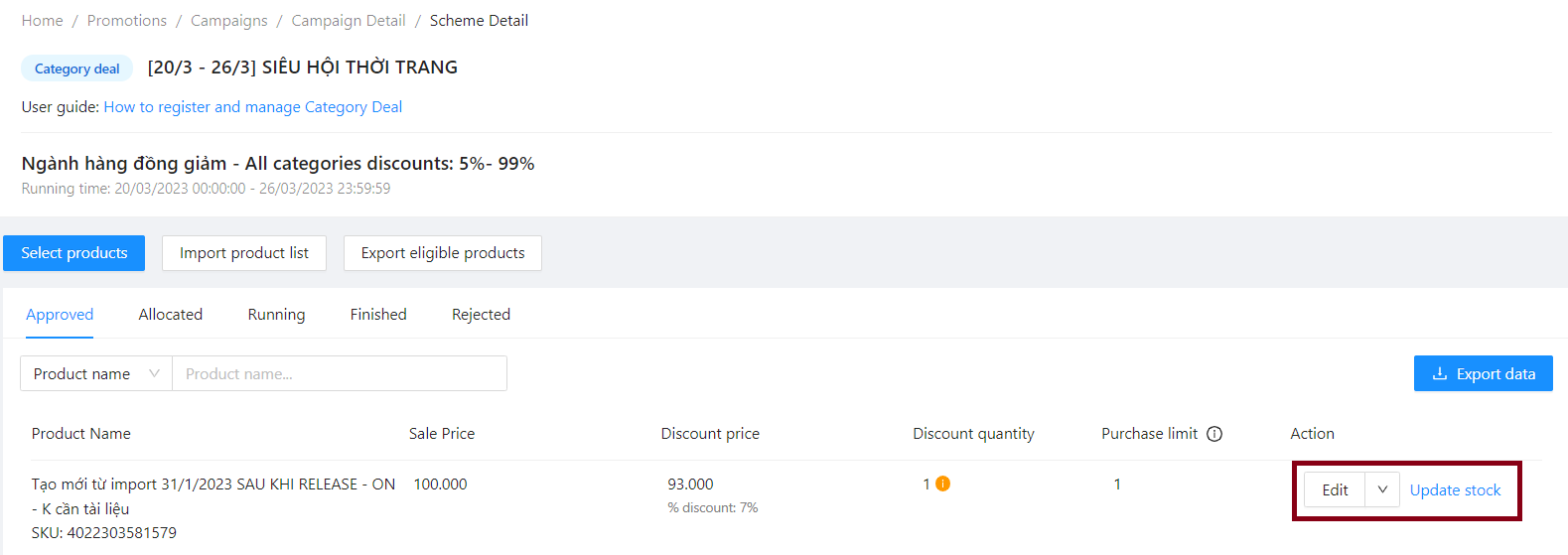
- Low-stock products: After registering the participating product, the system will warn the product with a lower stock than the discount quantity the seller has registered for the program as shown below. Sellers can choose to Update stock to ensure that products are not rejected when the system is making allocations. Note: Sellers can always directly update the inventory until before the campaign starts to ensure all the products are in stock.

Low-stock products in the campaign list
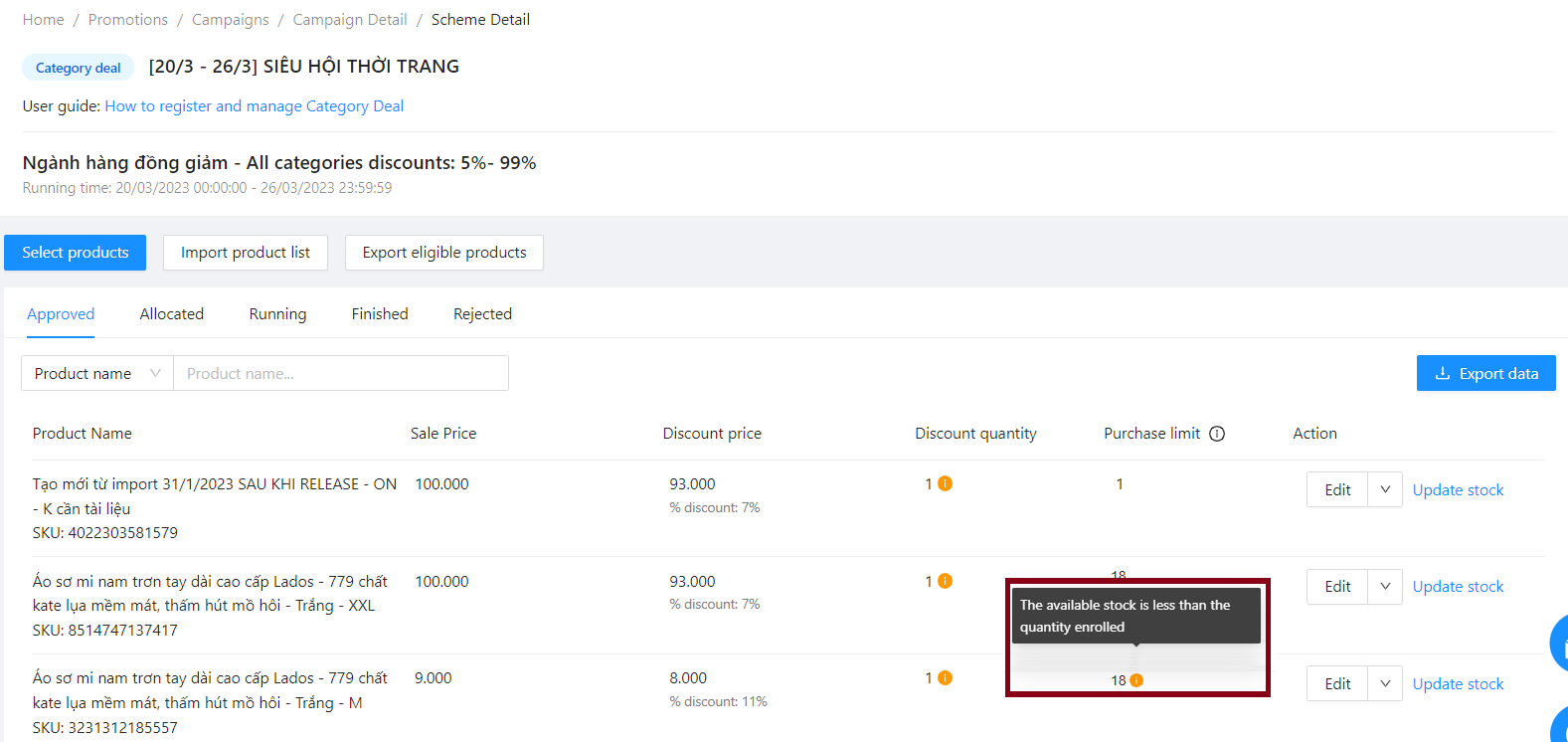
Low-stock products in campaign detail page
2. Allocated and Rejected tab
After the program expires, the system will distribute the Seller’s registered products. Sellers can check for the allocation schedule on the Campaign details page. The result of the allocation will have 2 cases:
-
Case 1: The product has been successfully allocated and is now visible on the Allocated tab, where it displays information about the product’s deal time frame for that day.
-
Case 2: The product is rejected, located in the Rejected section and shows the reason for the product rejection.
3. Running tab
On the date of Category deal activation, deals will be automatically moved to this tab, where sellers can see the quantity of products sold (real-time) and the revenue as well.
4. Finished tab
A list of products that have sold out of registration or if the campaign finished, such information will be shown here.
Sellers can efficiently manage registered ongoing campaigns with the Promotions Insight feature in the Growth Center.
Method 1: Log in to Seller Center > Marketing center > Promotion tools > All campaigns, the system will then navigate to the Campaign list where you should. Select View reports for each campaign in the Ongoing or Finished tab.

Method 2: Go to Seller Center > Growth Center > Select Promotions Insight > Select Campaign tab
See more instructions on how to view the report on the Growth Center here.
